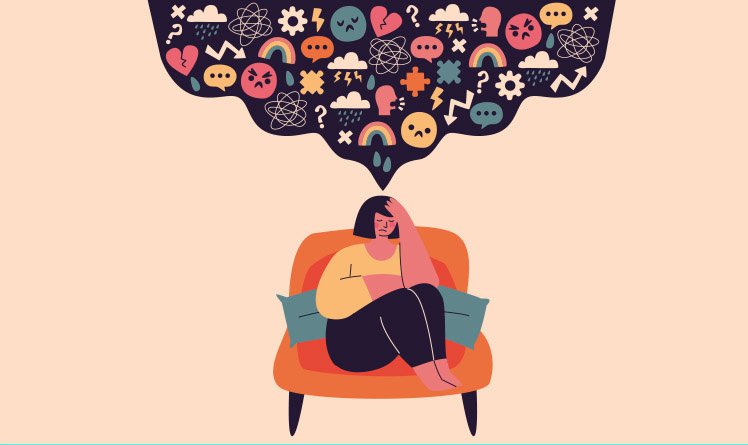Anxiety: the villain of the century

|
Getting your Trinity Audio player ready...
|
Anxiety, considered the “villain of the century,” is a persistent and overwhelming concern that affects millions of people around the world. In this article, we will explore what anxiety is, how it is diagnosed, and its impact on society.
Furthermore, it is worth talking about the Beck Scale, an important diagnostic tool, the treatments available and how it is possible to transform anxiety into an ally for success.
How is anxiety diagnosed?
Diagnosing anxiety can be challenging, as symptoms vary from person to person. It involves a careful assessment of the patient's symptoms and experiences by a mental health professional, such as a psychologist or psychiatrist.
Here are some important points involved in diagnosis:
1. Clinical interview:
The diagnostic process usually begins with a clinical interview, in which the patient discusses his or her symptoms, feelings, experiences, and medical history. It is important to be honest and open about your feelings and symptoms during this interview.
2. Diagnostic criteria:
Mental health professionals use specific criteria from the Diagnostic and Statistical Manual of Mental Disorders (DSM-5) to determine whether a patient's symptoms fit a specific anxiety disorder. The DSM-5 is a widely accepted tool that provides criteria for diagnosing mental disorders.
3. Assessment of symptoms:
The professional will assess the patient's symptoms, which may include excessive worry, muscle tension, restlessness, insomnia, irrational fears, panic attacks, and other symptoms. Symptoms must be persistent and cause significant distress to be considered an anxiety disorder.
4. Differentiation from other conditions:
It is important to rule out other medical or psychological conditions that may be contributing to the patient's symptoms. Additionally, mental health professionals must distinguish anxiety from other mental disorders, such as depression.
5. Use of assessment instruments:
In some cases, mental health professionals may use questionnaires and rating scales, such as the Beck Scale, to measure the severity of anxiety and track treatment progress.
6. Treatment and monitoring of anxiety:
Based on the diagnosis, the mental health professional will work with the patient to develop an appropriate treatment plan, which may include therapy, medication, lifestyle changes, and other interventions.
It is important to emphasize that an accurate diagnosis is essential to ensure that the patient receives the appropriate treatment.
Anxiety can range from mild to severe, and treatment can be tailored based on the severity of symptoms and the individual needs of the patient. Therefore, it is highly recommended to seek help from a mental health professional if you suspect that you are experiencing anxiety beyond what you consider your own normal range.
What is the Beck Scale?
The Beck Anxiety Scale, also known as the Beck Anxiety Inventory (BAI), is a widely used diagnostic tool. It consists of a self-report questionnaire that assesses the severity of symptoms.
Patients rate their experiences on a multiple-choice scale. The resulting score helps healthcare professionals determine the level of anxiety and plan appropriate treatment.
It consists of a series of questions that the individual answers based on their feelings and behaviors over the past two weeks. The questions focus on typical symptoms such as worries, excessive fears, restlessness, nervousness, among others.
The instrument helps to quantify the severity of anxiety, providing a total score that can vary depending on the intensity of the symptoms reported.
Anxiety in Brazil and the World
Anxiety is a global concern, affecting people all over the world, regardless of their background or culture. In Brazil, it is no different.
According to the World Health Organization (WHO), Brazil is the country with the highest rate of people with anxiety disorders in Latin America. Access to appropriate treatments and support is essential to address this growing problem.
How Are Anxiety Treatments Working?
Fortunately, awareness of anxiety has grown, leading to advances in treatment. Therapies such as cognitive behavioral therapy (CBT) can be highly effective in managing it. Another option that has been used is the practice of mindfulness, with extremely positive results.
Additionally, medications such as selective serotonin reuptake inhibitors (SSRIs) may be prescribed by mental health professionals if needed. The important thing is to seek help when needed and find the right treatment.
Turning Anxiety into an Ally for Success
Anxiety doesn't just have to be an obstacle, it also has to be an impetus for success. Turning it into an ally involves understanding your triggers and learning to use it as a source of motivation.
Many anxious people are highly creative and focused. With the right support, you can learn to channel that energy into meaningful achievements.
Anxiety can be a powerful emotion, and when directed constructively, it can drive action and success. Here are some tips to help you get there:
1. Self-awareness:
The first step is to recognize and understand your anxiety. Identify the situations or challenges that trigger it. This will help you understand what is happening and why you are feeling anxious.
2. Reframe anxiety:
Instead of viewing anxiety as a negative thing, try to change your perspective. See it as a source of energy and motivation. It can alert you to the importance of a challenge, giving you the motivation to prepare and take action.
3. Set clear goals:
Set specific, measurable goals for what you want to achieve. Having clear goals can help direct your anxiety toward a positive purpose.
4. Action plan:
Develop a step-by-step action plan to achieve your goals. Having a solid plan can reduce uncertainty and anxiety because you’ll know what you need to do next.
5. Acceptance of imperfection:
Recognize that no one is perfect, and anxiety is part of the journey. Don’t beat yourself up for feeling anxious. Instead, accept your emotions and keep moving forward.
6. Mindfulness and relaxation techniques:
Practices of mindfulness, such as meditation, can help calm the mind and reduce anxiety. Relaxation techniques, such as deep breathing, can also be helpful in managing anxiety.
7. Transform energy into action:
Instead of letting anxiety paralyze you, use that energy to take action. It can be a powerful motivator to complete tasks and face challenges.
8. Seek support for your anxiety:
Talking to a therapist or counselor may be helpful. They can help you develop strategies for coping in a healthy and productive way.
9. Celebrate small victories:
As you move toward your goals, celebrate your achievements, no matter how small. This will reinforce your sense of accomplishment and help reduce anxiety.
10. Persistence:
Remember that the path to success may be marked by challenges and moments of anxiety. Persistence is key. Don’t give up when you feel anxious; keep moving forward.
In short…
Anxiety is a ubiquitous reality that affects many individuals. However, with the right diagnosis, appropriate professional help and a positive approach, it is possible to not only manage anxiety but also use it as a springboard to success. Through awareness, understanding and treatment, it is possible to face the “villain of the century” and achieve a balanced and productive life.
Image: Freepik

Marcel Castilho is an expert in neuromarketing, neuroscience, mindfulness and positive psychology. In addition to being an advertiser, he also has a Master's degree in NLP – Neurolinguistic Programming. As the owner and founder of the communications agency VeroCom and also of the digital agency Vero Contents, he has been studying human behavior for over 30 years.


